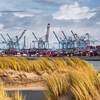A recent Formal Safety Assesment (FSA) for high speed catamaran ferries (HSC) has revealed the projected accident rate for this type of vessel is nearly five times the rate currently experienced. Also, the predicted risk level is considered high in relation to generally accepted limits of tolerability, arising from the potential for collision accidents at high speed in confined waters, such as coastal, port approach or harbor areas, where traffic density is likely to be highest.
The findings of this study prompted the U.K. to develop risk control options, which were evaluated for both their effectiveness at reducing the risk of accident, as well as the cost of implementation.
High speed catamaran ferries (HSC) constitute a rapidly developing sector of the shipping industry. Over the past few years, there have been significant increases in the numbers, size, speed and passenger capacity of this type of vessel, accompanied by new technological developments.
The trial application of the FSA method to HSCs was undertaken as part of the U.K.'s development of the FSA concept. HSC ferries were chosen as the theme for the work, as a test of the method and with a view to assessing the adequacy of existing requirements for this type of craft.
While the FSA is intended to address safety and environmental aspects, the scope of this study was confined only to the safety of people. Additionally, only selected accident categories were investigated:
· Collision (defined as the vessel striking, or being struck, by another vessel, regardless of whether either vessel is under way, anchored or moored; but excludes hitting underwater wrecks);
· Contact (defined as the HSC striking, or being struck, by an external object that is not another vessel or the sea bottom);
· Fire (defined as a process of combustion characterised by heat or smoke or flame or any combination of these); and
· Loss of hull integrity (defined as the consequence of certain initiating events that result in damage to the external hull of the HSC, or to the internal structure and subdivision; such that any compartment or space within a hull is opened to the sea or to another compartment or space).
Data relating to incidents in which HSC have been involved was collected from sources of three different types:
International (Category 1): Incidents reported at conferences, or in technical papers or other internationally available publications;
Local Authority (Category 2): Incidents reported to local or national authorities; and
Company Log (Category 3): Incidents of a minor nature, not otherwise reported.
The first step of the process, hazard identification, generates a prioritized list of hazards and identifies significant accident scenarios which are then taken forward for further development and analysis in step 2 (Risk Assessment).
Collision and contact accident sub categories were identified as being primarily related to the phase of operation of the HSC. Fire accident sub categories were defined according to the location within the vessel in which the fire initiates; and the loss of hull integrity accident sub categories were defined according to the part of the vessel's structure which fails.
The 220 incidents classified as being one of the accident categories are presented in Table 1. Significant conclusions regarding these accident types can be made:
1) The two accident categories that dominate on the basis of frequency of occurrence are collision and contact;
2) Collision is the more dominant of these two categories when considering the consequences of the accident occurring; and
3) There are significantly more minor (as defined by being reported more in the Category 2 data) contact incidents than collisions.
Table 1
Category of Data Source
1 2 3
Accident Category Total Number of Accidents Incidents Dead Major Minor Incidents Dead Major Minor Incidents Dead Major Minor
Collision 104 29 4 51 39 72 9 72 143 3 1 0 0
Contact 84 6 0 2 10 48 0 4 7 30 0 0 0
Loss of Hull Integrity 9 0 0 0 0 4 0 0 0 5 0 0 0
Fire 16 2 0 0 0 9 0 0 0 5 0 0 0
Near Misses 7 0 0 0 0 6 0 0 0 1 0 0 0
Total 220 37 4 53 49 139 9 76 150 44 1 0 0
Step 2 of the process details the assessment of the risk associated with the accident and accident sub categories identified in step 1. Participants structured "risk contribution trees" and finally calculated the potential loss of life (PLL).
Experts reviewed and validated the risk assessment, identifying the links between the influences. Each influence was rated on a scale of zero to one, demonstrating where experts considered the HSC industry to be on defined scales of best, intermediate and worst practice.
The calculated rating was then compared with the estimated rating assigned by the experts and a modified average rating was carried forward.
The Potential Loss of Life (PLL) for each accident category was calculated by integrating the product of the frequency and consequence values at the end of each branch of the event tree - in units of equivalent fatalities per vessel operating year. The PLL values were:
Collision 0.065
Loss of hull integrity 0.0060
Fire 0.0039
Contact 0.0024
Overall risk level 0.077
The Study Results
Risk is expressed in terms of the average number of equivalent fatalities expected per vessel per year. The study predicts a total risk for the accident categories studied of 0.077 equivalent fatalities per vessel operating year, which corresponds to approximately one equivalent fatality on every craft every 13 years. The calculation of equivalent fatalities assumes 100 minor injuries or 10 major injuries are equivalent to one fatality.
This is long-term average. The probability is most vessels will not experience any fatalities at all, but some vessels may be involved in a serious accident with multiple fatalities.
By comparison, the actual historical risk for the HSC accident categories is 0.017 equivalent fatalities per vessel operating year, or only one-fifth of the predicted future value.
The largest contribution to the predicted risk level is collision, which accounts for 84 percent of the total, principally arising from the potential for collisions at high speed in confined waters, such as the coastal, port approach or harbor phases of a typical HSC route.
HSC, like other types of ferry, are intended to carry large numbers of passengers. In a serious accident, therefore, there may be several fatalities. It is customary to characterize the severity of an accident as involving "N or more" fatalities, where N is a number such as 10, 20, 100, etc. A catastrophic accident may be characterized as one which kills 100 or more people, a major accident as one which kills 10 or more, etc.
The study predicts the future frequencies of accidents killing "N or more" people. The results are shown as a so-called "F-N" (frequency-N) line in Figure 1. Superimposed for comparison with the HSC predictions is the actual historical F-N line for RoRo ferry fatalities and tentative bounds of tolerable risk. The points at the right hand (high fatality) end of the RoRo line are respectively Estonia, Herald of Free Enterprise and Scandinavian Star.
A risk level falling within the region between the negligible and tolerable risk limits should be reduced, to the extent it is practical to do so. It was decided early action to reduce the risks on HSC is justified.
The study indicated the principal contribution to risk arises from collisions at high speed. Many existing risk control measures are already in place, and their effectiveness was taken into account during the study.
A variety of additional control measures was identified, from which three options were selected. These three options were considered to evaluate their likely effectiveness in reducing collision risk, and to determine their implementation costs:
1) Adoption of enhanced external vessel management arrangements, incorporating traffic separation schemes in congested waters and a shore-based advisory system covering port approach and departure, particular hazards, etc.;
2) Review of the Collision Regulations to take into account the difference in speed and maneuverability of HSC relative to conventional vessels, together with improved identification of HSC and improved aids to navigation; and
3) Development, through the IMO's Working Group on the Human Element, of improved operating and emergency procedures, together with improved "ownership" and adherence to procedures by onboard operating staff.
The study concluded each of these options would result in a significant reduction of predicted risk, typically by 40 percent of more. Additionally, the cost/benefit assessment of these options concluded their implementation would, overall, be economically attractive, since the costs of implementation are outweighed by the financial benefits that would accrue from the avoidance of accidents.
Jim Peachey was - until recently - head of the MCA's FSA branch, where he was responsible for leading the UK's development of FSA, and promoting the concept at the IMO. The MCA sponsored a major program of research to develop the FSA methodology, which included a trial application to high speed catamaran ferries. The results of this trial were reported to the IMO's Maritime Safety Committee and Design & Equipment Subcommittee last year.
On leaving the MCA earlier this year, Peachey has taken a post with engineering consultants BOMEL Ltd.
Sponsored Content
LR - Fit for 55: Managing compliance and optimising operations

Use Roxtec seals, services and software

Subscribe for
Maritime Reporter E-News
Maritime Reporter E-News is the maritime industry's largest circulation and most authoritative ENews Service, delivered to your Email five times per week









